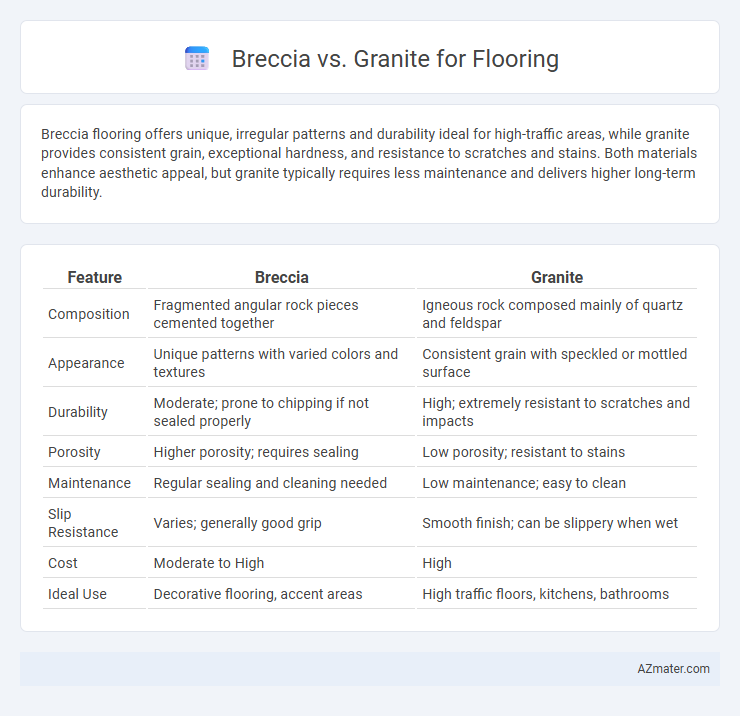Breccia flooring offers unique, irregular patterns and durability ideal for high-traffic areas, while granite provides consistent grain, exceptional hardness, and resistance to scratches and stains. Both materials enhance aesthetic appeal, but granite typically requires less maintenance and delivers higher long-term durability.
Table of Comparison
| Feature | Breccia | Granite |
|---|---|---|
| Composition | Fragmented angular rock pieces cemented together | Igneous rock composed mainly of quartz and feldspar |
| Appearance | Unique patterns with varied colors and textures | Consistent grain with speckled or mottled surface |
| Durability | Moderate; prone to chipping if not sealed properly | High; extremely resistant to scratches and impacts |
| Porosity | Higher porosity; requires sealing | Low porosity; resistant to stains |
| Maintenance | Regular sealing and cleaning needed | Low maintenance; easy to clean |
| Slip Resistance | Varies; generally good grip | Smooth finish; can be slippery when wet |
| Cost | Moderate to High | High |
| Ideal Use | Decorative flooring, accent areas | High traffic floors, kitchens, bathrooms |
Introduction to Breccia and Granite Flooring
Breccia and granite are popular natural stones used for flooring, each offering unique aesthetic and structural benefits. Breccia is a sedimentary rock composed of angular fragments cemented together, known for its distinctive patterns and rich color variations, making it ideal for decorative flooring applications. Granite is an igneous rock characterized by its durability, hardness, and speckled appearance, providing a long-lasting and low-maintenance flooring option suitable for high-traffic areas.
Composition and Formation Differences
Breccia flooring consists of angular, broken fragments cemented together, formed through sedimentary or volcanic processes, resulting in a mosaic-like appearance with varied colors and textures. Granite flooring is an igneous rock composed primarily of quartz, feldspar, and mica crystals that solidify slowly beneath the Earth's surface, producing a dense, durable, and uniform grain structure. Breccia's composite structure offers distinctive patterns and porosity, while granite provides enhanced strength and resistance to wear, influencing their suitability for different flooring applications.
Aesthetic Appeal: Patterns and Colors
Breccia flooring offers unique, dramatic patterns characterized by angular fragments in varied colors, creating a bold, artistic statement ideal for luxury interiors. Granite provides a more uniform appearance with natural speckles and a wide palette ranging from earthy tones to vibrant hues, lending timeless elegance and versatility. Both materials enhance spaces with distinct textures, but Breccia's striking contrasts attract attention, while Granite's consistent patterns ensure subtle sophistication.
Durability and Resistance to Wear
Breccia flooring offers impressive durability with its natural composition of fragmented rock cemented together, making it resistant to heavy foot traffic and impact. Granite is renowned for its exceptional hardness and wear resistance, providing long-lasting performance in high-traffic areas without significant surface degradation. Both materials deliver excellent resistance to abrasion, but granite typically outperforms breccia in maintaining a polished finish over extended periods.
Maintenance Requirements
Breccia flooring demands more frequent sealing to prevent staining due to its porous composition compared to granite, which is denser and more resistant to moisture. Regular cleaning with pH-neutral products is essential for both materials to maintain their polished appearance and prevent surface damage. Granite's superior durability reduces the need for intensive maintenance, making it more suitable for high-traffic areas requiring long-lasting performance.
Slip Resistance and Safety
Breccia offers a textured surface with natural fissures that enhance slip resistance, making it a safer option for flooring in wet or high-traffic areas. Granite, although highly durable and polished for a sleek look, can become slippery when wet, requiring additional treatments or mats to improve safety. Selecting Breccia flooring reduces the risk of slips and falls due to its naturally uneven surface characteristics compared to the smoother finish of granite.
Cost Comparison: Breccia vs Granite
Breccia flooring generally costs more than granite due to its rarity and unique veining patterns, with prices typically ranging from $15 to $30 per square foot compared to granite's $10 to $25 per square foot. Installation expenses for breccia can also be higher because of its softer texture, which requires careful handling to prevent damage. Granite remains a more budget-friendly option for durable and widely available flooring material.
Installation Considerations
Breccia flooring requires meticulous sealing and regular maintenance to prevent staining due to its porous nature, while granite offers superior durability and lower porosity, making it easier to clean and maintain in high-traffic areas. Installation of breccia demands skilled craftsmanship to align its unique veining patterns seamlessly, which can increase labor costs compared to granite's more uniform surface that simplifies cutting and fitting. Both materials necessitate a stable subfloor and professional adhesive application to ensure longevity and prevent cracking or shifting over time.
Best Applications and Room Suitability
Breccia, with its bold, fragmented patterns and natural fissures, excels in accenting feature walls or statement floors in living rooms and entryways where visual impact is desired. Granite offers unparalleled durability and resistance to scratching and heat, making it ideal for high-traffic areas such as kitchens, bathrooms, and commercial spaces requiring long-lasting flooring solutions. Both materials are suitable for flooring but choosing Breccia suits aesthetic-focused areas, while Granite is best for functional, heavy-use environments.
Environmental Impact and Sustainability
Breccia flooring often features natural stone composition that requires less intensive quarrying compared to granite, reducing habitat disruption and energy consumption during extraction. Granite, while incredibly durable, demands significant mining and processing efforts, contributing to higher carbon emissions and environmental degradation. Choosing Breccia supports sustainability by promoting the use of materials with a lower ecological footprint and encouraging responsible quarrying practices.

Infographic: Breccia vs Granite for Flooring
 azmater.com
azmater.com